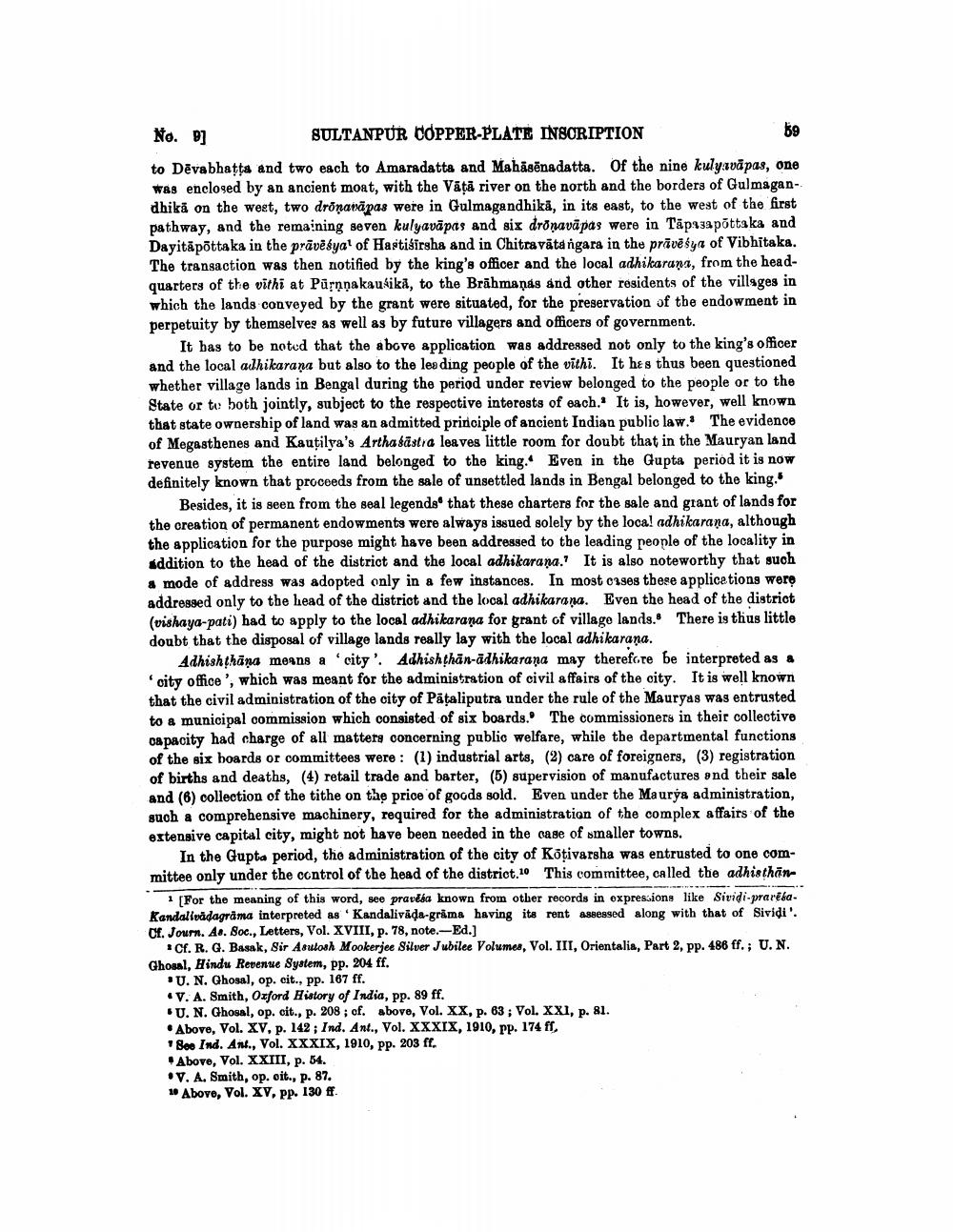________________
59
No. 9]
SULTANPUR COPPER-PLATE INSCRIPTION
to Devabhatta and two each to Amaradatta and Mahāsēnadatta. Of the nine kulyavapas, one was enclosed by an ancient moat, with the Vața river on the north and the borders of Gulmagandhika on the west, two dronaräpas were in Gulmagandhika, in its east, to the west of the first pathway, and the remaining seven kulyavapas and six dronavapas were in Tapaзapottaka and Dayitapōttaka in the prāvesya1 of Hastiśirsha and in Chitravata ngara in the prāvēśya of Vibhitaka. The transaction was then notified by the king's officer and the local adhikarana, from the headquarters of the vithi at Purnṇakausika, to the Brahmanas and other residents of the villages in which the lands conveyed by the grant were situated, for the preservation of the endowment in perpetuity by themselves as well as by future villagers and officers of government.
It has to be noted that the above application was addressed not only to the king's officer and the local adhikarana but also to the leading people of the vithi. It has thus been questioned whether village lands in Bengal during the period under review belonged to the people or to the State or to both jointly, subject to the respective interests of each. It is, however, well known that state ownership of land was an admitted principle of ancient Indian public law. The evidence of Megasthenes and Kautilya's Arthasästra leaves little room for doubt that in the Mauryan land revenue system the entire land belonged to the king. Even in the Gupta period it is now definitely known that proceeds from the sale of unsettled lands in Bengal belonged to the king."
Besides, it is seen from the seal legends" that these charters for the sale and grant of lands for the creation of permanent endowments were always issued solely by the local adhikarana, although the application for the purpose might have been addressed to the leading people of the locality in addition to the head of the district and the local adhikarana. It is also noteworthy that such a mode of address was adopted only in a few instances. In most cases these applications were addressed only to the head of the district and the local adhikarana. Even the head of the district (vishaya-pati) had to apply to the local adhikarana for grant of village lands. There is thus little doubt that the disposal of village lands really lay with the local adhikarana.
Adhishthana means a city'. Adhishthan-adhikarana may therefore be interpreted as a 'city office', which was meant for the administration of civil affairs of the city. It is well known that the civil administration of the city of Pataliputra under the rule of the Mauryas was entrusted to a municipal commission which consisted of six boards. The commissioners in their collective capacity had charge of all matters concerning public welfare, while the departmental functions of the six boards or committees were: (1) industrial arts, (2) care of foreigners, (3) registration of births and deaths, (4) retail trade and barter, (5) supervision of manufactures and their sale and (6) collection of the tithe on the price of goods sold. Even under the Maurya administration, such a comprehensive machinery, required for the administration of the complex affairs of the extensive capital city, might not have been needed in the case of smaller towns.
In the Gupta period, the administration of the city of Kotivarsha was entrusted to one committee only under the control of the head of the district. 10 This committee, called the adhisthan
1 [For the meaning of this word, see pravěéa known from other records in expressions like Sividi-prarēbaKandallvädagräma interpreted as Kandalivada-grama having its rent assessed along with that of Sividi'. Cf. Journ. As. Soc., Letters, Vol. XVIII, p. 78, note.-Ed.]
Cf. R. G. Basak, Sir Asutosh Mookerjee Silver Jubilee Volumes, Vol. III, Orientalia, Part 2, pp. 486 ff.; U. N. Ghosal, Hindu Revenue System, pp. 204 ff.
U. N. Ghosal, op. cit., pp. 167 ff.
V. A. Smith, Oxford History of India, pp. 89 ff.
U. N. Ghosal, op. cit., p. 208; cf. above, Vol. XX, p. 63; Vol. XXI, p. 81.
Above, Vol. XV, p. 142; Ind. Ant., Vol. XXXIX, 1910, pp. 174 ff,
See Ind. Ant., Vol. XXXIX, 1910, pp. 203 ff.
Above, Vol. XXIII, p. 54.
V. A. Smith, op. cit., p. 87.
19 Above, Vol. XV, pp. 130 ff.




